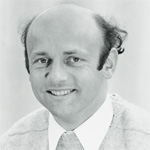On the hunt with CESAR
In 1962, Heribert Koziol took leave from the University of Graz, Austria, to work at CERN for one year on ultra-high vacuum. Through his work on CESAR, he went on to a permanent position at CERN as an accelerator physicist where he worked on many key accelerator projects.
 “For a 26 year old post-doc from a small physics institute to arrive at CERN was a radical change. Although I was used to international contact, to work in a multi-national group was a new and most enjoyable experience. When I arrived in 1962, the Accelerator Research Division was two years old, led by eminent accelerator physicists, and it had an exciting future-oriented programme. The leader of the CESAR group, Mike Pentz, was a dynamic, colourful person who instilled an open-minded, relaxed, yet hard-working atmosphere in the group.
“For a 26 year old post-doc from a small physics institute to arrive at CERN was a radical change. Although I was used to international contact, to work in a multi-national group was a new and most enjoyable experience. When I arrived in 1962, the Accelerator Research Division was two years old, led by eminent accelerator physicists, and it had an exciting future-oriented programme. The leader of the CESAR group, Mike Pentz, was a dynamic, colourful person who instilled an open-minded, relaxed, yet hard-working atmosphere in the group.
Colourful personalities were plentiful at CERN in those days. I remember colloquia in the auditorium with animated interjections and explosive discussions. At work too, one had to get along with highly original, not to say eccentric, characters. One of the liveliest places in the Division was the cafeteria with its vitally important blackboard. Everyone, from all rungs of the hierarchical ladder, gathered there. Discussions sprang up, the blackboard got filled, wiped, filled again, and often the discussion ended only because we had homes to go to! At that blackboard we learnt a lot, and it was there as well that I passed my selection board to become a CERN staff member without actually noticing it.
Eminent accelerator physicists came from the United States and the Soviet Union. Their visits led to successions of seminars, discussions on wild ideas for new methods of acceleration and long-lasting relations across the continents.
CESAR was difficult to handle, mostly because of its low magnetic fields. A highly capricious component was the van de Graaff generator. It needed painstaking preparation and, after closure of its pressure tank, careful conditioning to hold the voltage. Powerful bangs rang out when the van de Graaff’s 2 million volts sparked over, and the generator had to be run down quickly to avoid further sparks.
This led to a memorable event. The first circulating beam in December 1963 was celebrated with sparkling drinks. I connected my record player to the public address system for some appropriately lively music. I had chosen ‘On the Hunt’, a polka by Johann Strauss that begins with two pistol-shots. When a pair of 1 kW canon shots rang out across the CESAR hall from the public address loudspeakers, most of the sparkling drinks were spilt and the technician in charge of the van de Graaff made a desperate jump for the control rack to wind it down!
CESAR was a small machine, easily modified for new experiments. One Friday we decided to add two sextupole magnets to tickle a third-order resonance. One of us machined the cores, another wound the coils, a third organized the power supply and the group leader laid the cables. On Monday we studied third-order resonances.
Beyond our scientific and technical work, members of the CESAR group shared much of their private time and when CESAR was dismantled in 1967, life-long friendships remained.
Last but not least, CESAR was an excellent practical accelerator school, a nursery from which highly trained and motivated accelerator physicists emerged to make their imprint on CERN’s later machines.”

